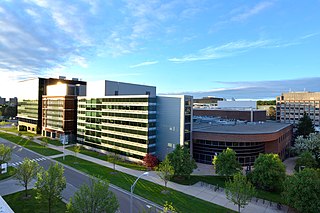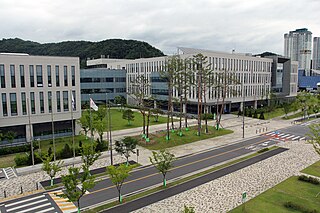Isotope separation is the process of concentrating specific isotopes of a chemical element by removing other isotopes. The use of the nuclides produced is varied. The largest variety is used in research. By tonnage, separating natural uranium into enriched uranium and depleted uranium is the largest application. In the following text, mainly uranium enrichment is considered. This process is crucial in the manufacture of uranium fuel for nuclear power plants and is also required for the creation of uranium-based nuclear weapons. Plutonium-based weapons use plutonium produced in a nuclear reactor, which must be operated in such a way as to produce plutonium already of suitable isotopic mix or grade.

The GSI Helmholtz Centre for Heavy Ion Research is a federally and state co-funded heavy ion (Schwerion) research center in the Wixhausen suburb of Darmstadt, Germany. It was founded in 1969 as the Society for Heavy Ion Research, abbreviated GSI, to conduct research on and with heavy-ion accelerators. It is the only major user research center in the State of Hesse.

Brookhaven National Laboratory (BNL) is a United States Department of Energy national laboratory located in Upton, New York, a hamlet of the Town of Brookhaven. It was formally established in 1947 at the site of Camp Upton, a former U.S. Army base on Long Island. Located approximately 60 miles east of New York City, it is managed by Stony Brook University and Battelle Memorial Institute.

The National Superconducting Cyclotron Laboratory (NSCL), located on the campus of Michigan State University was a rare isotope research facility in the United States. Established in 1963, the cyclotron laboratory has been succeeded by the Facility for Rare Isotope Beams, a linear accelerator providing beam to the same detector halls.

TRIUMF is Canada's national particle accelerator centre. It is considered Canada's premier physics laboratory, and consistently regarded as one of the world's leading subatomic physics research centres. Owned and operated by a consortium of universities, it is on the south campus of one of its founding members, the University of British Columbia in Vancouver, British Columbia, Canada. It houses the world's largest normal conducting cyclotron, a source of 520 MeV protons, which was named an IEEE Milestone in 2010. Its accelerator-focused activities involve particle physics, nuclear physics, nuclear medicine, materials science, and detector and accelerator development.

The ISOLDE Radioactive Ion Beam Facility, is an on-line isotope separator facility located at the centre of the CERN accelerator complex on the Franco-Swiss border. Created in 1964, the ISOLDE facility started delivering radioactive ion beams (RIBs) to users in 1967. Originally located at the Synchro-Cyclotron (SC) accelerator, the facility has been upgraded several times most notably in 1992 when the whole facility was moved to be connected to CERN's ProtonSynchroton Booster (PSB). ISOLDE is currently the longest-running facility in operation at CERN, with continuous developments of the facility and its experiments keeping ISOLDE at the forefront of science with RIBs. ISOLDE benefits a wide range of physics communities with applications covering nuclear, atomic, molecular and solid-state physics, but also biophysics and astrophysics, as well as high-precision experiments looking for physics beyond the Standard Model. The facility is operated by the ISOLDE Collaboration, comprising CERN and sixteen (mostly) European countries. As of 2019, close to 1,000 experimentalists around the world are coming to ISOLDE to perform typically 50 different experiments per year.

The Argonne Tandem Linac Accelerator System (ATLAS) is a U.S. Department of Energy scientific user facility at Argonne National Laboratory. ATLAS is the first superconducting linear accelerator (linac) for heavy ions at energies in the vicinity of the Coulomb barrier and is open to scientists from all over the world.

Variable Energy Cyclotron Centre (VECC) is a premier research and development unit of the Department of Atomic Energy, Government of India. The VECC has three campuses located in Kolkata, India and performs research in basic and applied nuclear sciences and development of the latest nuclear particle accelerators. It has a collaboration with the European Organization for Nuclear Research. The Centre houses a 224 cm cyclotron—the first of its kind in India—which has been operational since 16 June 1977. It provides proton, deuteron, alpha particle and heavy ion beams of various energies to other institutions.

Muon spin spectroscopy, also known as μSR, is an experimental technique based on the implantation of spin-polarized muons in matter and on the detection of the influence of the atomic, molecular or crystalline surroundings on their spin motion. The motion of the muon spin is due to the magnetic field experienced by the particle and may provide information on its local environment in a very similar way to other magnetic resonance techniques, such as electron spin resonance and, more closely, nuclear magnetic resonance (NMR).
A radio-frequency quadrupole (RFQ) beam cooler is a device for particle beam cooling, especially suited for ion beams. It lowers the temperature of a particle beam by reducing its energy dispersion and emittance, effectively increasing its brightness (brilliance). The prevalent mechanism for cooling in this case is buffer-gas cooling, whereby the beam loses energy from collisions with a light, neutral and inert gas. The cooling must take place within a confining field in order to counteract the thermal diffusion that results from the ion-atom collisions.
The EURISOL project is aimed at the design and eventual construction of a 'next-generation' European ISOL radioactive ion beam (RIB) facility capable of extending current research in atomic and nuclear physics by providing users with a wide variety of exotic ion beams at intensities far greater than those presently available. The first phase of the project, completed in 2003, set out to determine the feasibility of the project. Phase 2, the EURISOL Design Study, is currently underway and is scheduled to last 4 years. Meant to identify the technological challenges facing the construction of the EURISOL facility, the Design Study has been divided into 12 sub tasks each focusing on a particular aspect of the facility's creation.

A neutron research facility is most commonly a big laboratory operating a large-scale neutron source that provides thermal neutrons to a suite of research instruments. The neutron source usually is a research reactor or a spallation source. In some cases, a smaller facility will provide high energy neutrons using existing neutron generator technologies.

The Facility for Rare Isotope Beams (FRIB) is a scientific user facility for nuclear science, funded by the U.S. Department of Energy Office of Science (DOE-SC), Michigan State University (MSU), and the State of Michigan. Michigan State University contributed an additional $212 million in various ways, including the land. MSU established and operates FRIB as a user facility for the Office of Nuclear Physics in the U.S. Department of Energy Office of Science. At FRIB, scientists research the properties of rare isotopes to advance knowledge in the areas of nuclear physics, nuclear astrophysics, fundamental interactions of nuclei, and real-world applications of rare isotopes. Construction of the FRIB conventional facilities began in spring 2014 and was completed in 2017. Technical construction started in the fall of 2014 and was completed in January 2022. The total project cost was $730M with project completion in June 2022.

The Pakistan Atomic Research Reactor or (PARR) are two nuclear research reactors and two other experimental neutron sources located in the PINSTECH Laboratory, Nilore, Islamabad, Pakistan.

The Facility for Antiproton and Ion Research (FAIR) is an international accelerator facility under construction which will use antiprotons and ions to perform research in the fields of: nuclear, hadron and particle physics, atomic and anti-matter physics, high density plasma physics, and applications in condensed matter physics, biology and the bio-medical sciences. It is situated in Darmstadt in Germany.

The Soreq Applied Research Accelerator Facility (SARAF) is a superconducting radiofrequency linear accelerator and neutron source, located at the Soreq Nuclear Research Center in Yavne, Israel. Its highly configurable neutron spectrum and produced range of light radionuclides makes it suitable for a range of research topics that previously required a nuclear reactor, such as fusion reactor material studies, producing radionuclides and astrophysics research.
The Synchro-Cyclotron, or Synchrocyclotron (SC), built in 1957, was CERN’s first accelerator. It was in circumference and provided for CERN's first experiments in particle and nuclear physics. It accelerated particles to energies up to 600 MeV. The foundation stone of CERN was laid at the site of the Synchrocyclotron by the first Director-General of CERN, Felix Bloch. After its remarkably long 33 years of service time, the SC was decommissioned in 1990. Nowadays it accepts visitors as an exhibition area in CERN.

The Institute for Basic Science is a Korean government-funded research institute that conducts basic science research and relevant pure basic research. Comprising approximately 30 research centers with more than 60 research groups across the nation and a headquarters in Daejeon, IBS has approximately 1,800 researchers and doctoral course students. Around 30% of the researchers are from countries other than South Korea. The organization is under the Ministry of Science and ICT.
The Laboratori Nazionali di Legnaro is one of the four major research centers of the Italian National Institute for Nuclear Physics (INFN). The primary focus of research at this laboratory is in the fields of nuclear physics and nuclear astrophysics, where five accelerators are currently used. It is one of the most important facilities in Italy for research in these fields. The main future project of the laboratory is the Selective Production of Exotic Species (SPES), in which various radionuclides will be produced for research and medicinal purposes.

Kevin Insik Hahn is a South Korean physicist who is an expert in the fields of nuclear physics and nuclear astrophysics. Since December 2019, he has been the director of the Center for Exotic Nuclear Studies at the Institute for Basic Science (IBS) in South Korea. He also holds an endowed professorship in the Department of Science Education at Ewha Womans University, where he has worked since 1999. In his research, he has worked on accelerator-based as well as non-accelerator-based experiments. His current research activities involve a number of accelerators around the world, including the RI Beam Factory (RIBF) at RIKEN, Relativistic Heavy Ion Collider (RHIC) at Brookhaven National Laboratory, and the soon-to-open Rare isotope Accelerator complex for ON-line experiment (RAON). During his tenure at Ewha Womans University, he promoted STEM/STEAM education by serving for multiple years as the director of the Advanced STEAM Teacher Education Center. He also wrote several physics textbooks for high school students and undergraduate students.

















